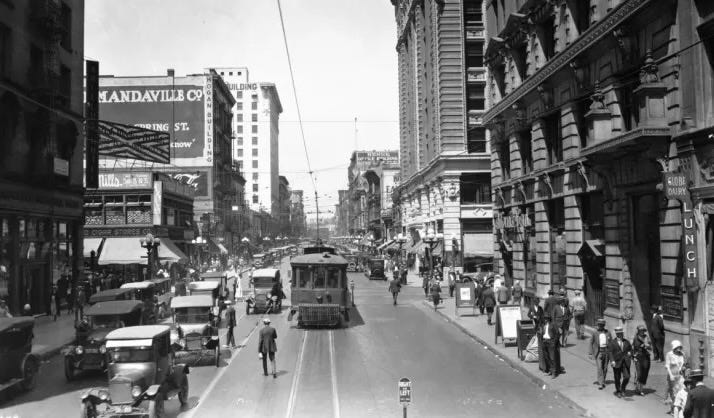Los Angeles v London, cars v people
100 years of contrasting car regulation - story 45
Perhaps it was the absurdity of encountering a 16-lane freeway on what should have been a mundane grocery run in Dallas, Texas, where I find myself this week—a city where the scale of car dominance feels so alien.
Whatever the reason, Reena Mahajan’s exploration of the 100-year legacy of car-centric urban planning feels particularly resonant.
She traces its roots back to a 1925 Los Angeles ordinance that reshaped not only American cities but influenced urban development worldwide. The full story of the English teacher who played a pivotal role in transforming LA’s streets is worth a read.

I stumbled over one of the first sentences.
In 2022, 42,514 people died in traffic violence on America’s road and streets.
For comparison, in the UK that same year, 1,766 people died in car-related incidents. Put another way, 0.13% of Americans died in car-related incidents compared to 0.0003% in the UK.
The road not taken
These numbers aren’t accidents of history. They’re the result of deliberate policy choices. While both the U.S. and the UK saw an explosion in car ownership after World War II, their regulatory responses diverged dramatically.
The Los Angeles Traffic Ordinance of 1925 criminalised jaywalking, effectively turning streets into high-speed corridors for automobiles and relegating pedestrians to second-class status. This was a watershed moment: cities across the U.S. followed LA’s lead, laying the groundwork for a car-dependent nation. It wasn’t just about traffic laws—it was about who streets were designed for.
We took a different road.
Forgive the pun. While Britain, too, saw a postwar boom in car ownership, it never fully embraced the American model of unrestricted car dominance. The contrast between the two countries' regulatory approaches helps explain why British cities today are moving toward walkability and traffic reduction, while much of the U.S. remains locked in a car-centric reality.
Jaywalking laws and pedestrian rights
Unlike the U.S., the UK never criminalised jaywalking. Pedestrians retain the right to cross streets freely unless explicitly restricted. The legacy of LA’s 1925 ordinance, which reinforced the idea that streets belong to cars, contrasts with Britain’s more pedestrian-friendly urban fabric—particularly in historic city centres like London. The UK Highway Code update in 2022 formalised this with a hierarchy of road users, granting pedestrians and cyclists priority at junctions—essentially the inverse of LA’s century-old stance.
American cities continue to widen roads but London especially has spent over twenty years pursuing policies to curb car dependence:
Congestion Charging (2003) discourages driving in central London.
Low Traffic Neighborhoods (LTNs) limit car access to residential streets, favoring walking and cycling.
Ultra Low Emission Zones (ULEZ) target high-emission vehicles, reducing urban pollution.
Designing for people, not drivers
Postwar Britain flirted with America’s suburban model—Milton Keynes being the prime example. But crucially, UK planners never fully surrendered cities to the car. That decision has left room for a future where walking, cycling, and public transit aren’t just alternatives to driving, but in London the default.
A century after LA’s fateful decision to criminalise, or should that be criminalize, walking, American cities are grappling with the consequences: sprawl, congestion, and a road safety crisis. Britain, especially London, though far from perfect, shows what happens when cities put people before cars.
